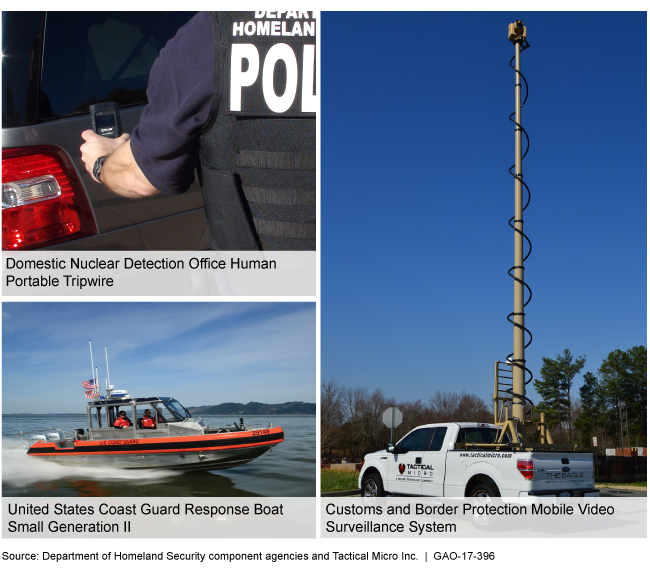Homeland Security Acquisitions: Identifying All Non-Major Acquisitions Would Advance Ongoing Efforts to Improve Management
Fast Facts
The Department of Homeland Security purchases many systems—such as for nuclear detection and search and rescue—that help it execute critical missions. And, while it has improved its management of major acquisitions, its non-major acquisitions (generally those that cost less than $300 million) haven't received as much attention—though DHS did make improvements during the course of our audit.
We found that DHS planned to spend more than $6 billion on non-major acquisitions in fiscal year 2016, but could not successfully identify them all. We recommended that DHS establish time frames to identify all its non-major acquisitions.
Examples of DHS's Non-Major Acquisitions

Three photos of DHS's non-major acquisitions.
Highlights
What GAO Found
The Department of Homeland Security's (DHS) component agencies—such as the U.S. Coast Guard and Customs and Border Protection—lack the information needed to effectively oversee their non-major acquisitions because they cannot confidently identify all of them. They identified over $6 billion in non-major acquisitions; however, GAO found 8 of the 11 components could not identify them all. Several officials indicated that their focus had been on major acquisitions historically, and they had not turned their attention to non-major acquisitions until more recently. Many component officials said they were still in the process of identifying all of these acquisitions, but it was unclear when they would complete these efforts. DHS headquarters had not established time frames for components to do so, which may have resulted in components losing traction in their efforts. Federal internal controls standards establish that management should obtain relevant data from reliable sources in a timely manner. Another key challenge involves the use of baselines, which establish a program's critical cost, schedule, and performance parameters. Component officials identified 38 non-major acquisitions that were active at the start of fiscal year 2017 (as opposed to acquisitions that have been delivered to end users and are considered to be non-active). GAO found that most of the active non-major acquisitions (23 of 38) did not have approved baselines, and that the value of the acquisitions without baselines constituted nearly half of the total value of the active acquisitions.
Value of Active Non-Major Acquisitions Identified by Components as of October 1, 2016

At the beginning of fiscal year 2017, some components did not require approved baselines. However, in response to GAO's preliminary findings, in February 2017, DHS required component leadership to approve baselines for non-major acquisitions, which should help components oversee them more effectively.
DHS headquarters is taking steps to help components establish more effective management controls for non-major acquisitions. In 2015, DHS headquarters officials established a process to review them annually. In February 2017, in response to GAO's preliminary findings, DHS established that components shall use the annual reviews to assess the extent to which non-major acquisitions are on track to meet cost, schedule, and performance parameters from approved baselines. DHS leadership has also established ongoing reporting requirements for non-major acquisitions. All components have started entering non-major acquisition data into DHS's central acquisition information system, and headquarters officials are taking steps to improve the reliability of these data.
Why GAO Did This Study
Each year, DHS acquires a wide array of systems intended to help its component agencies execute their many critical missions. GAO has previously reported that DHS's process for managing its major acquisitions is maturing. However, non-major acquisitions (generally those with cost estimates of less than $300 million) are managed by DHS's component agencies and have not received as much oversight. Recently GAO reported on a non-major acquisition that was executed poorly, limiting DHS's ability to address human capital weaknesses.
GAO was asked to examine DHS's management of non-major acquisitions. This report assesses: (1) the extent to which component leadership is effectively overseeing non-major acquisitions; and (2) the extent to which DHS headquarters has helped components establish effective management controls for non-major acquisitions.
GAO reviewed policy and component guidance, and interviewed officials from DHS headquarters and 11 components responsible for managing non-major acquisitions. GAO also traced non-major acquisition data from DHS's central acquisition data system to source documents to assess data reliability.
Recommendations
GAO recommended that DHS headquarters establish time frames for components to identify all non-major acquisitions. DHS concurred with GAO's recommendation and directed components to identify all non-major acquisitions by October 31, 2017.
Recommendations for Executive Action
| Agency Affected | Recommendation | Status |
|---|---|---|
| Department of Homeland Security | To improve the management of the Department of Homeland Security non-major acquisitions, the Secretary of Homeland Security should direct the Under Secretary for Management to establish a time frame for components to identify all of their non-major acquisitions. |
Closed – Implemented
In providing comments on this report, the Department of Homeland Security (DHS) concurred with this recommendation and indicated that the Under Secretary for Management had directed Component Acquisition Executives to identify all non-major acquisitions across DHS by no later than October 31, 2017. We reviewed the supporting documentation provided by DHS and determined that this direction addressed the recommendation.
|
